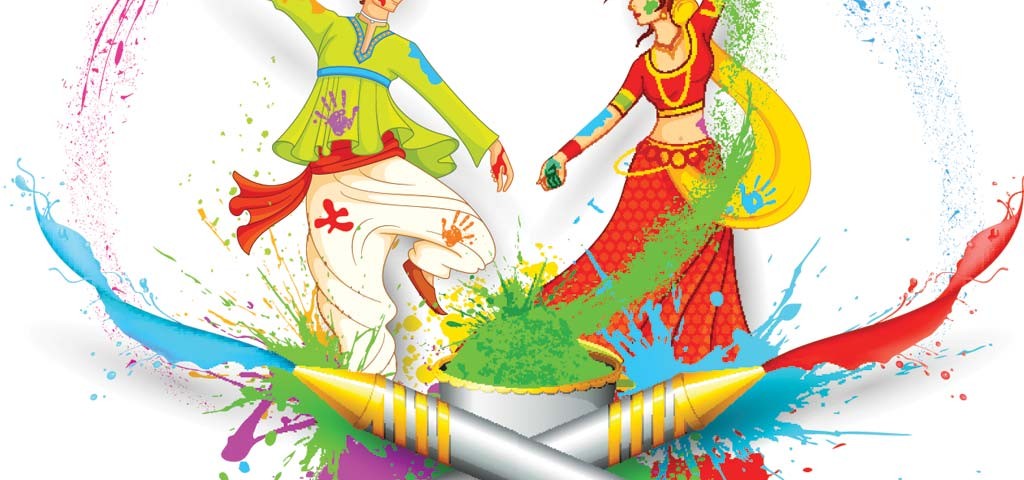
Maha Shivraatri
September 26, 2019
Saraswati Jayanti
September 30, 2019Holi, the vibrant celebration also known as Phagwah, it is also called “The Festival of Colours”, a day and time to play with coloured powders, have fun, herald the return of spring, and to celebrate good conquering evil.” This is a great synopsis if you’re ever explaining what it is to friends. However, it doesn’t give the reason as to why we actually celebrate it. So, let us take a moment, and make this journey to discover the purpose behind Holi.
Let’s start with a bit of background…
Holi is celebrated as the return of spring in Hinduism, and it is closely aligned with the Vernal Equinox. It marks the beginning of a new cycle, new life, brightness, longer days, and beautiful colors. It is the rebirth of the world from the slumber of winter. Herbs, flowers, trees, shrubs, fruits, all follow in different stages of awakening and maturity to light up and nourish our world. This stimulates us all, it fills us all with hope and joy, it rejuvenates us both physically and spiritually.
In Spring, ‘love’, the beauty of ‘life’, and the Spirit of Exuberance are present everywhere. It stirs us to find the best within us and to embrace attitudes of wellness for all and the planet. Songs of love, life, respect, appreciation, admiration flow from us in seeming streams. Worries, concerns, sadness, despair, negative qualities which make us unwell, are abandoned for some time at least. It makes us turn our hearts to the Divine to offer thanks and appreciation, to be blessed to see many more springs, and to utilize this season as a way to light up our inner being.
Holi is celebrated over two days and on the eve of Holi, bon-fires called Holika are lit. People bring things from the past year such as old clothes, toys, memorabilia – things that don’t serve a purpose to them anymore – and burn them in the fire, this is done mainly in India. It is a way to part with the past, and be re-born again, looking forward to a more joyful and productive life. The fire also symbolizes the burning away of bad thoughts, memories, sins anything that has made us feel shame, guilt and anguish, thus starting the season as a new person and to live better than before.
There are many stories in our Scriptures that mark this observation of Holi, but three of these stories are recognized as the most significant; the kid-devotee Prahalad, God of Desire –Kaamadeva, and the miraculous baby Krishna. Because of their antiquity and geography, they’ve gone through many variations. If you’d like to know more, you can find details in the Srimad Bhaagwat Puraana, and other Hindu Scriptures and Puraanas.
The next segment is the abstract of the Three Stories Marking the Holi Celebration
The First Story – The Kid-Devotee Prahalad
Prahalad was the youngest son of the Asura (Demon) King Hiranyakshipu. Being an Asura (demon), Prahalad was required to follow the ways of his demonic family by worshipping King Hiranyakshipu. At an early age, Prahalad would sing songs of devotion, pray and meditate constantly to the Supreme Vishnu. His father, the King, tried many strategies to stop this. He changed his teachers, applied punishment, locking him away in a cell for days at a time, but Prahalad continued his worshipping to Bhagwaan Vishnu. Prahalad’s suggestions and advice to his Asura family and friends has become some of the central teachings and example in the Yoga of Devotion to this day.
Many attempts were made to kill this little boy, but in very miraculous ways, all these attempts failed. Finally, the infuriated King decided that Prahalad had to disappear. The King had a sister named Holika, who had a magical cloak/robe gifted to her in her youth, that would protect her from fire. A deceptive arrangement was made by Holika and her brother, the King, to utilize her special gift to bring about the end of the young boy. She took him in her embrace and sat in a place where a fire pit/pyre was secretly hidden. The flames engulfed the two of them, but in the greatest of miracles the boy came out of the fire unscathed but Holika did not. Lord Vishnu had come to his rescue and removed the robe from Holika and placed it on Prahalad instead.
Even more infuriated, the King then started to approach the boy to kill him, but Bhagwaan Vishnu in the form of Narsimha (man-lion) avataar slayed the Demon King. Vishnu gave Prahalad a boon, but all the child devotee wanted was to always worship Vishnu and to keep his mind focused on him. Vishnu granted this boon and also made the boy the King. Those who put Sri Bhagwaan first in their minds can conquer many obstacles.
Long before this event occurred, Hindus who are mainly agrarian were in the habit of reaping their spring crop just about this time. The first grains picked was called Hola. Each farmer provided stalks of the first grains into a community chest which was set alight as a huge offering on the fulling of the Phalgun moon. It was in such a pyre that Holika sat with Prahalaad. Since then the pyre became known as Holika and its burning symbolizes the burning of evil – thoughts, words and deeds -errors and mistakes made during that year which now needs to be set aside and start anew. Spring is the rejuvenation of nature and a fresh start for us because of the social significance of the occasion.
The Second Story – God of Desire – Kaamadeva
Kama is the god of love, the Hindu Cupid, capable and responsible for driving the darts of lust and desire into everyone – man or God. Shiva had left the world and went into meditation. Shiva’s wife, Parvati, missed her husband so much that she wanted him to come back to the world to be with her. She asked Kama to help. So he visited Shiva, who was in meditation, and tried to awaken him, but there was no response. He then decided to discharge his arrows of desire to awaken him. Awoken from his Yogic activity, and very agitated, Lord Shiva opened his 3rd eye (still with his other eyes closed) and sent a beam of fire to Kama. Kama was burnt to ashes and desire vanished from the world. Kama’s wife Rati was grief stricken and upset. She meditated upon Shiva for a long time. Shiva, listened to her prayers and restored Kama to life. Upon Kama’s return, Love also returned to the world but in a purified form. The return of Kama is celebrated in some parts of the world as Holi, when Love lost is restored
The Third Story – The miraculous baby Krishna
This day is also observed to celebrate the destruction of the female Asura (demoness, ogress), Poothana. When Krishna was a baby Poothana(Asura/Demon) , went to Gokul (Krishna’s childhood village) to kill the child. Her special power was that she could produce poison within her body and disguise it as milk. So, disguising herself as a nanny, she deceived Mother Yashoda (Krishna’s adoptive mother) and got access to the baby Krishna. She went into the chamber where Krishna was sleeping and breastfed him. As Krishna began to drink the milk he started turning blue, but instead of letting go, he held on and drank all the poison, and as a results removed the life from the Poothana. Writhing and screaming in agony, she fell to the ground dead in her demon form. As she fell, she tore down many buildings and the noise of her falling could be heard across the entire village. The people of Gokul came running to the scene and were shocked and amazed to find the dead Asura, and babe Krishna on her playing as if nothing had happened. They simply attributed all the miraculous things he did to his divine origins.
The Asura’s body was hacked into pieces and loaded onto a lit bonfire from which a fragrant scent emanated. This was the miraculous power of Sri Krishna and the idea that even a wicked creature could be purified by coming into contact with him.
How do we Celebrate Holi? With exuberance of course!
The festive part of Holi begins on the second day, where participants are encouraged to throw coloured water and powders on each other. This represents Krishna’s mischievous ways as a child; wanting to have fun and embracing the vibrancy of life. The coloured powders symbolize the essence of life and exuberance.
Some of us can not celebrate Holi as we would like. If you live in a cold climate, don’t have access to coloured powders,can’t use powders for health purposes, or can’t play indoors due to clean up – it can impact the spirit of the day. But, where nature and circumstances are against us, we must make it up with our smiles, our joy, and show our exuberance for life. Becoming new again and ushering in a good year for growth.
Holi is an event that is meant to bring us at ease. But for many of us in our busy hectic lives, we’ve let our thoughts define and control us. But we must not allow them to take away from our quality of life and happiness. So on this day we burn away all negativity, and blooming into something new and joyful. The season of spring and celebration of Holi is to remind us to be at maximum aliveness.
The stories give us history behind this festive day. The fires represent burning away the past, replacing evil with good. The colours are to show the joys of life, love, forgiveness, accepting others,and mending broken relations with family and friends.
By The Hindu Professional Society of Canada (HPSC)

